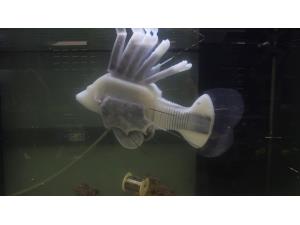



Date:21/06/19
 Researchers have created a robotic fish powered by a battery fluid that its developers dub ‘robot blood’.
Researchers have created a robotic fish powered by a battery fluid that its developers dub ‘robot blood’.
The roughly 40-centimetre soft robot doesn’t have solid batteries — instead it is propelled by a dual-function fluid that stores energy and moves the fish’s fins. The approach allows the machine to store more energy in a smaller space and operate for longer periods without the need for heavy and cumbersome battery packs.
The innovation is a step towards creating autonomous robots — those that can perform tasks without human intervention or guidance, says Robert Shepherd, a roboticist at Cornell University in Ithaca, New York, who was part of the team that built the robot. The researchers describe their machine in a Nature paper published on 19 June1.
Making robots autonomous for extended periods of time is a key challenge in robotics. Autonomous robots could have myriad applications, for example in performing search and rescue missions and in deep-sea exploration, says Cecilia Laschi, a roboticist at Sant’Anna School of Advanced Studies–Pisa in Italy.
But one of the major problems is energy storage: the robots need enough power to perform tasks without having to recharge. Simply adding batteries increases the weight of the robot, so it requires more power to move.
Instead of using conventional hydraulic fluid, which typically circulates around machines to move their parts, Shepherd’s team used a battery fluid that powered the robot and also powered a pump to move the fins, making the fish swim.
The approach increased the amount of energy stored in the robot by 325%, compared with a machine that has a separate battery and hydraulic-fluid system, says Shepherd. The team calculated that the robot would be able to function for 37 hours without requiring recharging.
Laschi agrees that the robot is a step towards autonomy. “I find the idea fantastic, it’s a very original idea,” she says.
Robo-fish powered by battery ‘blood’
 Researchers have created a robotic fish powered by a battery fluid that its developers dub ‘robot blood’.
Researchers have created a robotic fish powered by a battery fluid that its developers dub ‘robot blood’.The roughly 40-centimetre soft robot doesn’t have solid batteries — instead it is propelled by a dual-function fluid that stores energy and moves the fish’s fins. The approach allows the machine to store more energy in a smaller space and operate for longer periods without the need for heavy and cumbersome battery packs.
The innovation is a step towards creating autonomous robots — those that can perform tasks without human intervention or guidance, says Robert Shepherd, a roboticist at Cornell University in Ithaca, New York, who was part of the team that built the robot. The researchers describe their machine in a Nature paper published on 19 June1.
Making robots autonomous for extended periods of time is a key challenge in robotics. Autonomous robots could have myriad applications, for example in performing search and rescue missions and in deep-sea exploration, says Cecilia Laschi, a roboticist at Sant’Anna School of Advanced Studies–Pisa in Italy.
But one of the major problems is energy storage: the robots need enough power to perform tasks without having to recharge. Simply adding batteries increases the weight of the robot, so it requires more power to move.
Instead of using conventional hydraulic fluid, which typically circulates around machines to move their parts, Shepherd’s team used a battery fluid that powered the robot and also powered a pump to move the fins, making the fish swim.
The approach increased the amount of energy stored in the robot by 325%, compared with a machine that has a separate battery and hydraulic-fluid system, says Shepherd. The team calculated that the robot would be able to function for 37 hours without requiring recharging.
Laschi agrees that the robot is a step towards autonomy. “I find the idea fantastic, it’s a very original idea,” she says.
Views: 510
©ictnews.az. All rights reserved.Similar news
- Azerbaijani project to monitor disease via mobile phones
- Innovative educational system to be improved under presidential decree
- NTRC prolongs license of two TV and radio organizations for 6 years
- Azerbaijan establishes e-registry for medicines
- Azerbaijani museum introduces e-guide
- Nar Mobile opens “Nar Dunyasi” sales and service center in Siyazan city
- International conference on custom electronic services held in Baku
- OIC secretary general to attend COMSTECH meeting in Baku
- Azerbaijan develops earthquake warning system
- New law to regulate transition to digital broadcasting in Azerbaijan
- Azerbaijani State Social Protection Fund introduces electronic digital signature
- Intellectual traffic management system in Baku to be commissioned in December
- Tax Ministry of Azerbaijan started receiving video-addresses
- World Bank recommends Azerbaijan to speed up e-service introduction in real estate
- Azerbaijan to shift to electronic registration of real estate





















